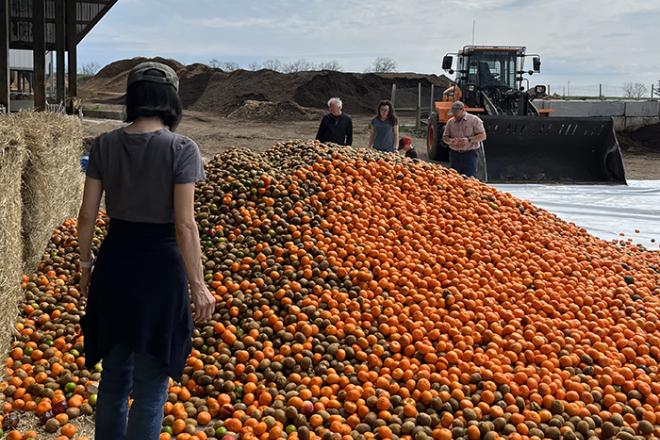Tackling Food Waste: Innovations from Farm to Dining Hall
Food waste is a global crisis with environmental, economic, and ethical implications.

by Stuti Mankodi
What is the first image that comes to mind when you think about food waste? Is it the unfinished bits on your plate after a meal? The old lettuce and cheese you toss when you clean out your refrigerator? Or perhaps the leftover meals a restaurant made that went uneaten. In reality, the problem of food waste is much larger: it’s a global crisis with environmental, economic, and ethical implications. According to the United Nations, about one-third of all food produced for human consumption is wasted every year. Food loss and waste occurs at every stage of food production — from farms to kitchens to consumers — and contributes significantly to greenhouse gas emissions.
At Penn, researchers and practitioners come at the food waste problem from many directions. There are faculty such as Zhengxia Dou, a professor of agricultural systems, whose research at the School of Veterinary Medicine’s New Bolton Center addresses agricultural nutrients and sustainable food security issues. In campus dining, we have professionals in food sourcing and preparation like Chef Shazad Khan and Director of Operations Steven Green from Penn Dining. To understand efforts to reduce food waste at different points in the system, the Environmental Innovations Initiative spoke with all three of these experts. They shared insights into both upstream agricultural innovations and downstream dining practices on campus.
Q. How do you define the food waste problem?
Zhengxia Dou: Food loss and waste occur throughout the supply chain — production in the agriculture fields, post-harvest handling, processing, distribution, marketplace, and consumption. Fruits and vegetables, which are nutritious but perishable, have the highest loss and waste rates — about half of the total. Some losses result from human ignorance, poor management, or consumer pickiness. Even slightly blemished produce retains nutritional value, but consumers often reject it, leading to unnecessary waste.
Steven Green: We define food waste as anything that was purchased and prepared to be served but does not get served. Our hierarchy for handling food waste prioritizes repurposing it, sending it to biofuel or animal feed, composting, and only as a last resort, landfilling.
Shazad Khan: From a culinary side, food waste includes everything from production scraps, such as pineapple skins, to leftovers from catered events. We track food waste closely and make operational decisions based on it. Food waste management is treated with the same level of importance as safety and sanitation in our meetings.
Q. How do you approach food waste in your work?
Dou: We partnered with a local fruit processing center to collect discarded citrus waste and incorporated it into cows’ diets at our research dairy farm at New Bolton Center. This practice reduced landfill emissions, displaced standard feed ingredients like corn and hay, and still maintained milk yield and quality. Later, we experimented with preserving fresh fruit waste through fermentation to extend its usability. We have also tested vegetable and fruit mixtures in laboratory studies.
Green: We focus on repurposing food through donations, using surplus food for animal feed, creating biofuel, or composting, always aiming to keep waste out of landfills. We collaborate closely with partners like Bennet Compost to manage our waste responsibly.
Shazad: Whenever we have surplus due to event overestimates or closures, we engage in food recovery programs, donating food in prime condition to local organizations. Planning menus carefully, training chefs, and continuously reviewing waste data help us cut down unnecessary waste. Every week we meet to discuss waste management, in addition to finances and safety.
Q. What challenges make food waste hard to eliminate?
Dou: Consumer behavior is a major challenge. In developed countries, food is cheap and abundant, so people often don't appreciate the resources used to produce it. There's also a lack of connection between consumers and the food production process. Raising awareness is essential to change behavior.
Green: Mindfulness around portion control is key. While Penn Dining works hard to reduce waste behind the scenes, it's equally important for students and other diners to be mindful about how much they take. Choosing reasonable portions helps prevent waste at the consumer end.
Khan: The all-you-can-eat style in dining halls can sometimes encourage students to take more food than they need. We try to address this by educating students through waste awareness events, where they can see firsthand how much food waste accumulates from a dining hall in a single day.

Q. What innovations or future solutions are exciting?
Dou: Zero landfill food waste policies are crucial. We need a combination of composting, anaerobic digestion, and animal feed solutions. I'm excited about emerging work using insects like black soldier flies to turn food waste into protein sources for animal feed, or even ingredients for potential human uses.
Green: Compostable materials are improving. More compostable napkins, plates, and containers are becoming available, and industry partners are prioritizing sustainable packaging. Our focus now includes working with vendors who provide compostable, recyclable materials, especially for takeout containers after the rise in to-go dining during COVID.
Khan: Technology is evolving rapidly. We are beginning to see robotic cooking systems and AI-supported kitchen operations, which could help optimize portion sizes and further reduce waste. Programs like Waste Not already allow us to track daily waste levels. We also recently introduced the Reuzzi app, which helps students manage reusable to-go containers, encouraging sustainable habits through simple mobile tracking.
Q. How important is consumer awareness and behavior change?
Dou: Awareness is powerful. Once consumers realize the fertilizers, fuel, land, and labor embedded in every apple or pepper, they begin to respect food more and waste less.
Green: Mindfulness and consciousness at both the front end — choosing portions carefully — and the back end — separating waste properly — are critical. No waste program can succeed without the active participation of consumers.
Khan: Students at Penn are generally informed and motivated to help, and we believe there's always room to grow. Showing students tangible data about waste volumes or having them see where their compost goes makes a lasting impact. Seeing the full cycle — from food production to waste recovery — builds a stronger sustainability mindset.
Food Waste Supply Chains
Fresh produce is discarded routinely in large volume during sorting, grading, and re-packaging before reaching stores for consumers, much of which could be upcycled instead of landfilled, Zhengxia Dou explains. Better management across the supply chain is needed, she says: Every ton of food waste diverted away from landfills for recycling is a ton of carbon dioxide avoided. Government incentives, she notes, would be helpful to encourage alternative uses for food waste, as upfront investment and infrastructure are critical to successful diversion efforts.
Penn Dining’s Broader Sustainability Efforts
Penn Dining collaborates across divisions at the University, working with Facilities and Real Estate Services and partners like Bennett Compost to manage food waste, while participating in hyper-local initiatives like herb gardens and partnerships with academic departments. One such partnership is with the DumoLab Research group in the Department of Architecture at the Weitzman School of Design. The DumoLab team—which consists of architects, designers, biologists and materials scientists—is at the forefront of developing bio-based alternatives to un-sustainable building and manufacturing materials. DumoLab Director and Assistant Professor of Architecture Laia Mogas-Soldevila approached Penn Dining’s Sustainability Coordinator Elise Dudley about collecting waste from Penn Dining for her lab. After visiting Hill House to share a presentation with Executive Chef Mouhamed Mboup about their research, DumoLab has been collecting food waste from Hill House, including fruit skins and egg shells. After collection, these eggregate materials are processed through dessication and grinding, and ultimately formed into bricks or tiles. The hope is that eggregate materials could one day replace synthetic or petroleum-based products for the insulation of buildings or find other applications in architecture and design.
Both Steven Green and Shazad Khan emphasize the importance of making sustainability a mindset, encouraging both staff and students to think consciously about their impact, not just follow rules. Shazad notes that, even behind the scenes, food recovery efforts are treated with great care — associates treat donated food as if they were preparing meals for their own families.
Through initiatives like Reuzzi, food recovery donations, composting programs, and a strong partnership with vendors and composting services, Penn Dining is aiming to reduce food waste by 50% by 2030.
Zhengxia Dou, PhD
Professor, Agricultural Systems
Penn School of Veterinary Medicine
Working at Penn Vet’s New Bolton Center, Dr. Dou’s research addresses agricultural nutrients and sustainable food security issues. Current work focuses on leveraging livestock to promote a circular food system, and developing strategies and finding ways to help make livestock farming more of the solution for sustainable food security and less of a problem.

Steven Green
Director of Operations
Penn Dining
Having worked his way up through four campus chef positions over nearly a decade, Steven Green now oversees all dining operations at Penn. His responsibilities include supporting front-of-house managers, collaborating with chefs, and ensuring seamless day-to-day functioning across Penn Dining locations, with a strong focus on service quality, coordination, and operational strategy.

Shazad Khan
Director of Culinary, Campus Executive Chef
Penn Dining
Bringing experience from both fine dining and corporate food service with Compass Group, Shazad Khan’s role centers on directing culinary operations across residential, retail, and catering services at Penn. His responsibilities include leading chef training, developing menus, ensuring food safety and sanitation, and advancing sustainability efforts, while also planning strategically for future culinary initiatives on campus.

LEARN MORE
"Leveraging dairy cattle to upcycle culled citrus fruit for emission mitigation and resource co-benefits: A case study." https://doi.org/10.1016/j.resconrec.2024.107452
"Food waste used as a resource can reduce climate and resource burdens in agrifood systems." https://www.nature.com/articles/s43016-025-01140-z
"A critical analysis of challenges and opportunities for upcycling food waste to animal feed to reduce climate and resource burdens." https://doi.org/10.1016/j.resconrec.2024.107418
Penn Dining Instagram https://www.instagram.com/reel/DICTenpOu82/?igsh=bGgzc2pidXFsZWpw
USDA Food Waste FAQs https://www.usda.gov/about-food/food-safety/food-loss-and-waste/food-waste-faqs
Glossary
- Food waste generally refers to edible food discarded at retail or consumer levels, often due to reasons like spoilage, plate waste, or cosmetic imperfections. Through a broader lens, food loss and waste occurs at every stage of food production — from farms to kitchens to consumers.
- Food sourcing refers to the process of obtaining food from suppliers, whether local farmers, large distributors, or other businesses.
- Food security is the state of having reliable access to a sufficient quantity of affordable, nutritious food.
- Agricultural nutrients are essential elements that plants require for growth and development and are thus crucial for crop production. The three primary macronutrients are nitrogen (N), phosphorus (P), and potassium (K).
- Landfill food waste policies aim to reduce food waste going to landfills by promoting diversion to other uses like composting, anaerobic digestion, or donation. These policies can take the form of bans on food waste disposal in landfills, setting targets for reduction, and incentivizing food donation and recycling.
- Composting is the managed, aerobic (oxygen-dependent) biological decomposition of organic materials by microorganisms.
- Anaerobic digestion is a biological process in which microorganisms break down biodegradable organic matter in the absence of oxygen. This process produces biogas, a mixture of gases primarily consisting of methane and carbon dioxide, along with a nutrient-rich liquid called digestate.